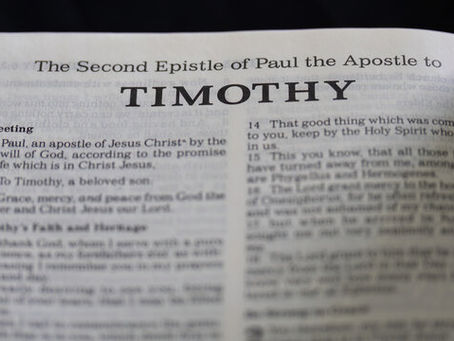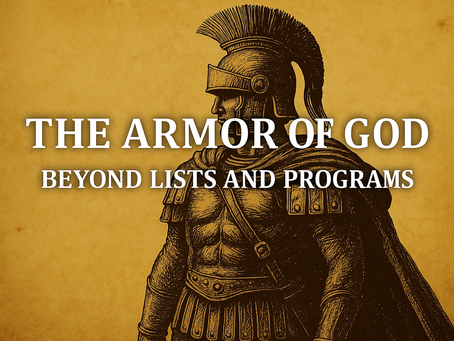top of page


Book of Philemon Summary: Forgiveness, Brotherhood, and the Gospel in Action
Book of Philemon Summary: Forgiveness, Brotherhood, and the Gospel in Action. The Letter to Philemon is the shortest of Paul’s writings, but it may be the most personal. Addressed not to a congregation but to an individual, Philemon reveals the power of the gospel to transform relationships. At its center is the story of Onesimus, a runaway slave who encountered Paul, became a believer, and was sent back to his master Philemon.
4 min read


Book of Titus Summary: Sound Doctrine and Godly Living on Crete
Book of Titus Summary: Sound Doctrine and Godly Living on Crete. The Letter to Titus is one of Paul’s most concentrated pastoral writings, brief yet packed with instructions on sound doctrine, leadership, and Christian living. Addressed to Titus, Paul’s trusted delegate in Crete, it provides a blueprint for establishing order in a new church setting. At its heart, Titus emphasizes the inseparable link between belief and behavior: true doctrine must always produce godly living
4 min read


Book of 2 Timothy Summary: Faithful to the End
Book of 2 Timothy Summary: Faithful to the End. 2 Timothy is Paul’s final letter, written from prison in Rome with the shadow of death looming over him. It carries the tone of a farewell testament, combining personal affection with urgent exhortation. Paul writes to his “beloved son” in the faith, Timothy, urging him to remain steadfast in the gospel amid hardship, false teaching, and persecution.
5 min read


Book of 1 Timothy Summary: Guarding the Gospel and Ordering the Church
Book of 1 Timothy Summary: Guarding the Gospel and Ordering the Church. 1 Timothy is one of the most personal and pastoral letters in the New Testament. Addressed to Paul’s trusted co-worker Timothy, it provides instruction on guarding the purity of the gospel, confronting false teaching, and ordering life within the church. More than just a manual for church structure, it is a heartfelt charge for faithful ministry in the face of opposition.
5 min read


Book of 2 Thessalonians Summary: Perseverance and Misunderstood Prophecy
Book of 2 Thessalonians Summary: Perseverance and Misunderstood Prophecy. 2 Thessalonians is a follow-up to Paul’s first letter to the Thessalonian church, written only a short time later. Whereas 1 Thessalonians emphasized encouragement and hope in the face of persecution, 2 Thessalonians addresses confusion about the timing of Christ’s return.
5 min read


Book of 1 Thessalonians Summary: Hope, Endurance, and the Return of Christ
Book of 1 Thessalonians Summary: Hope, Endurance, and the Return of Christ. 1 Thessalonians is widely considered Paul’s earliest surviving letter, written to encourage a young church under persecution and to correct misunderstandings about Christ’s return. Though brief, it is deeply pastoral, revealing Paul’s heart for the fledgling Thessalonian believers.
5 min read


Honoring Your Parents: Biblical Command, Limits, and Christ-Centered Application
Honoring Your Parents: Biblical Command, Limits, and Christ-Centered Application. The command to honor one’s parents is one of the most well-known in Scripture. It is often quoted as an absolute — “Honor your father and mother” — yet for many, the reality of parental relationships is not simple. What does this command mean for Christians today, especially for those who have faced manipulation, neglect, or abuse from their parents?
4 min read


Book of Colossians Summary: Christ Over All
Book of Colossians Summary: Christ Over All. Colossians is Paul’s exalted vision of Christ as supreme over creation, the church, and every spiritual power. Written to a community Paul had not personally founded, the letter is both pastoral and theological, addressing false teachings that threatened to diminish Christ’s sufficiency.
6 min read


The Trinity: The God Who Is Three-in-One
The Trinity: The God Who Is Three-in-One. The doctrine of the Trinity stands as one of the central mysteries of the Christian faith. It is not a philosophical abstraction but the reality of God as revealed in Scripture: Father, Son, and Holy Spirit — three distinct persons, yet one God. The term Trinity (trias in Greek, trinitas in Latin) does not appear in the Bible, but the reality saturates both Old and New Testaments.
5 min read


Anxiety and the Christian Life: Wrestling with Paul, Jesus, and Reality
Anxiety and the Christian Life: Wrestling with Paul, Jesus, and Reality. One of the most quoted verses in Philippians is Paul’s admonition: “Do not be anxious about anything” (Phil. 4:6). Many Christians take this as a command, and when they inevitably feel anxious, they experience guilt on top of their worry. But what did Paul actually mean? And how does this line harmonize with the rest of Scripture — especially considering that both Paul and Jesus themselves experienced de
3 min read


The Carmen Christi: Christ’s Humility and Exaltation in Philippians 2
The Carmen Christi: Christ’s Humility and Exaltation in Philippians 2. Few passages in Scripture rise to the poetic and theological height of Philippians 2:6–11. Known as the Carmen Christi (“Hymn to Christ”), this section is widely recognized as one of the earliest Christian confessions of faith, possibly a hymn sung in the earliest churches. Paul incorporates it into his letter not merely as doctrine, but as the ultimate example of humility for believers to imitate.
4 min read


Book of Philippians Summary: Joy in Christ Amid Chains
Book of Philippians Summary: Joy in Christ Amid Chains. The letter to the Philippians is often called Paul’s “letter of joy,” but that joy is no shallow optimism. It was written from prison, under chains, with the real possibility of death ahead. Despite those circumstances, Paul presents one of the most uplifting and Christ-centered writings in the New Testament. Philippians reveals what true Christian joy looks like: not rooted in circumstances, but in Christ Himself.
4 min read


The Armor of God: Beyond Lists and Programs
The Armor of God: Beyond Lists and Programs. Few passages in Paul’s letters capture the imagination like Ephesians 6:10–18, where he calls believers to “put on the full armor of God.” For centuries, Christians have drawn strength from the imagery of helmets, shields, and swords. Yet too often, this has been reduced to a rigid checklist or a “spiritual warfare program,” as if Paul intended a formula for battle.
4 min read


Book of Ephesians Summary: The Church in Christ
Book of Ephesians Summary: The Church in Christ. Ephesians is Paul’s grand vision of the church — not as an institution, but as the body of Christ, chosen before creation, redeemed by His blood, and empowered by the Spirit. Where Galatians thunders against false gospels, Ephesians soars in worshipful praise and cosmic perspective. It lifts believers’ eyes to God’s eternal plan in Christ, then brings that vision down into practical instructions for daily life.
6 min read


The Fruit of the Spirit vs. the Sin of the Flesh: Evidence of Salvation
The Fruit of the Spirit vs. the Sin of the Flesh: Evidence of Salvation. The Christian life is not defined merely by what we claim with our lips but by what is produced in our lives. Jesus said, “You can identify them by their fruit, that is, by the way they act… A good tree can’t produce bad fruit, and a bad tree can’t produce good fruit.” (Matt. 7:16, 18, NLT). Paul echoes this in Galatians 5, contrasting the works of the flesh with the fruit of the Spirit.
3 min read


Book of Galatians Summary: Freedom in Christ
Book of Galatians Summary: Freedom in Christ. The letter to the Galatians is Paul at his most fiery and passionate. Written to a group of churches in the Roman province of Galatia, it tackles a crisis: false teachers had infiltrated, insisting Gentile believers must obey the Jewish law — especially circumcision — in order to be saved. Paul responds with urgency: salvation comes by grace through faith in Christ, not by works of the law.
5 min read


Book of 2 Corinthians Summary: Strength in Weakness
Book of 2 Corinthians Summary: Strength in Weakness. 2 Corinthians is one of Paul’s most personal and emotional letters. Unlike Romans, which reads like a theological essay, this letter reveals Paul’s heart: his pain, his defense of his ministry, and his encouragement to a church that doubted him. It is a book of paradoxes — boasting in weakness, strength through suffering, and God’s power displayed in fragile vessels.
4 min read


Saying “Jesus is Lord”: Spirit, Rhetoric, and Reality
Saying “Jesus is Lord”: Spirit, Rhetoric, and Reality. In 1 Corinthians 12:3, Paul makes a striking claim: “No one can say, ‘Jesus is Lord,’ except by the Holy Spirit.” At first glance, this raises questions. People can mouth those words today without any transformation. Even Jesus Himself warned: “Why do you call me ‘Lord, Lord,’ and not do what I say?” (Luke 6:46).
3 min read


Book of 1 Corinthians Summary: The Gospel in a Divided Church
Book of 1 Corinthians Summary: The Gospel in a Divided Church. 1 Corinthians is a letter from Paul to the church in Corinth, a wealthy, diverse, and notoriously immoral port city. The church reflected its culture: divided, proud, morally compromised, and confused about spiritual gifts, worship, and resurrection. Paul’s letter confronts sin, corrects errors, and calls the church to unity under Christ.
5 min read


Book of Romans Summary: The Gospel of God’s Righteousness
Book of Romans Summary: The Gospel of God’s Righteousness. Paul’s letter to the Romans is his most thorough explanation of the gospel. Written to a church he had not yet visited, Romans lays out the righteousness of God revealed in Jesus Christ — available to Jew and Gentile alike through faith. Romans is both theological and practical: it begins with the universal problem of sin, moves to justification by faith, and ends with how believers should live together in unity and m
5 min read
bottom of page